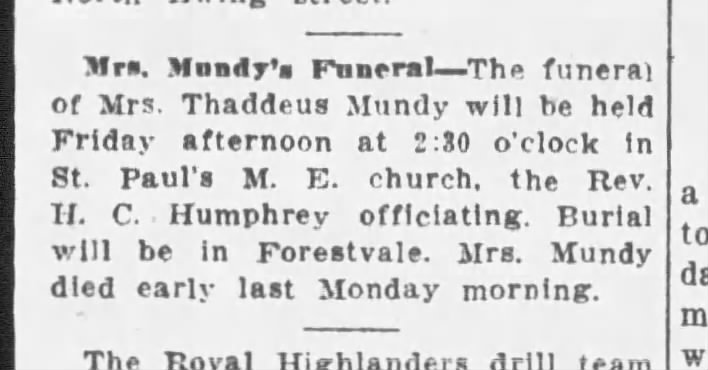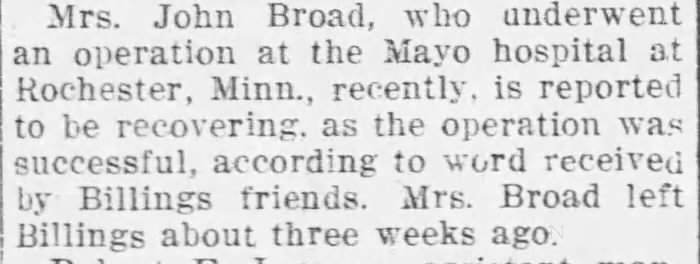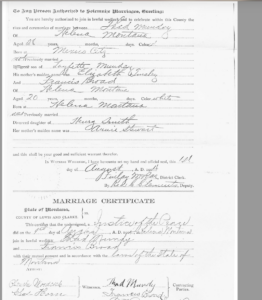Date of Birth
Febuary 6, 1884
Place of Birth
Radersburg, Broadway Country, Montana
Towns / Cities Moved Into
Lewis and Clark Country, Montana
Known Occupation
Religion
-
Spouse
Death Information
Year of death
Febuary 18, 1924
Place of death
Lewis and Clark Country, Montana
Cause of death
Childbirth
Parents
Annie Stewart
Henry Smith
Marital Status


Married thaddeus mundy
August 1, 1904
Montana
Siblings



Children










Narrative / Story
Francis Leona Mundy was born in the rugged frontier town of Radersburg, Montana, in the year 1884. Born into a world of vast landscapes and untamed wilderness, Francis grew up during a time of great change and challenges, especially as a white woman in the late 19th century American West.
Life in Radersburg, Montana, in 1884 was characterized by the ruggedness and hardships of frontier living. The town was nestled amidst the picturesque Rocky Mountains, and its economy primarily revolved around mining and ranching. As a frontier settlement, access to modern amenities was limited, and everyday life required resilience and self-sufficiency.
Being a white woman in this era presented unique challenges and societal expectations. Women of the late 19th century were often expected to conform to traditional gender roles, with their primary focus being on domestic duties, motherhood, and supporting their husbands. Opportunities for education and professional careers were limited, and women’s rights were still in the early stages of advocacy.
In the year 1900, Francis Leona Smith found love and companionship when she married John F. Broad in the bustling city of Helena, Montana. Life during that time was characterized by a blend of tradition and modernization. As a young couple starting their life together, Francis and John navigated the challenges and opportunities of the early 20th century. The turn of the century marked a period of transition in the United States, with advancements in technology and industry shaping the nation’s landscape. However, societal norms and gender roles still held sway, and women like Francis often faced expectations of domesticity and motherhood. They had three children: Mary E, Frances and Edwin. Unfortunately they divorced three years after in 1903.
In 1904, Francis Leona Mundy made a significant and daring decision that would forever change her life. She chose to marry Thaddeus Sumner Mundy, a man with whom she had fallen deeply in love. However, this marriage was unlike any other in Helena, Montana, and would go on to become the last interracial marriage in the state before it was outlawed.
For Francis and Thaddeus, their love transcended the societal norms and racial prejudices of their time. Their decision to marry faced fierce opposition, particularly from Francis’ parents, Annie and Henry. Upon learning of their daughter’s intention to marry a man of a different race, they disowned her, cutting all ties with her.
During this era, racial prejudice and discrimination were deeply ingrained in society, especially in regions like Helena, Montana. Interracial marriages were met with widespread disapproval and hostility from many segments of society. Miscegenation laws, also known as anti-miscegenation laws, were in place in several states, including Montana, explicitly prohibiting marriages between different racial groups. These laws sought to reinforce the racial hierarchy and maintain the segregation of different racial communities.
Frances Leona Mundy’s life journey, marked by love, courage, and resilience, came to a tragic end on February 18, 1924, at her residence in Dry Gulch, Helena. Her untimely death in childbirth was a poignant reminder of the challenges faced by women during that time, highlighting the risks associated with childbirth and limited access to proper medical care. Her passing was mourned by her loved ones and the community that had witnessed her strength and defiance against societal norms.
Throughout her life, Frances had defied convention and followed her heart, including her courageous choice to marry Thaddeus Mundy Smith despite the disapproval of many. Her union with Thaddeus was a testament to the enduring power of love, even in the face of discrimination and adversity.
Frances’s life intersected with a transformative moment in history – the fight for women’s suffrage. She was part of a generation that witnessed the hard-fought battle for women’s right to vote. In 1920, just a few years before her passing, the 19th Amendment to the U.S. Constitution was ratified, finally granting women the right to vote nationwide. Frances might have been one of the women who cast her ballot for the first time, savoring the realization of a hard-won victory for women’s rights.
Although Frances’s life was cut short, she lived during a time of great social change, witnessing the progress made in the struggle for equality and justice. The ratification of the 19th Amendment was a significant milestone, and even in her final days, Frances saw the potential for a more inclusive and equitable society.



